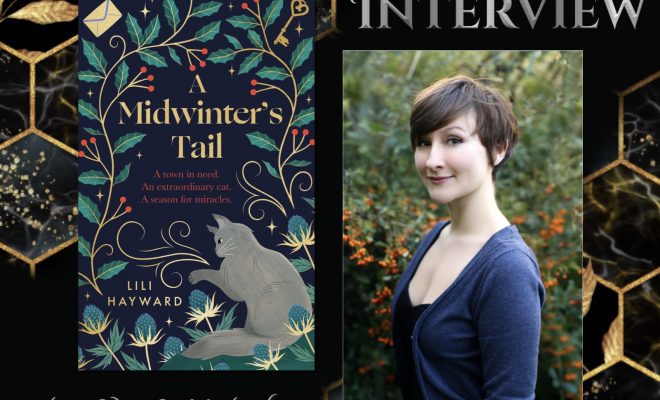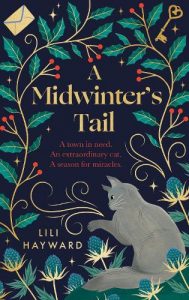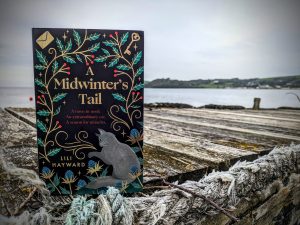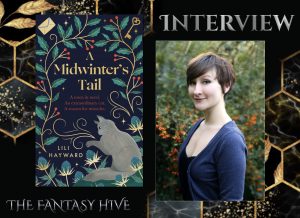Interview with Lili Hayward (A MIDWINTER’S TAIL)

Lili Hayward (otherwise known as bestselling historical fiction author Laura Madeleine) is a writer from the West Country with a love for folklore and magical tales. She lives in Somerset with her partner and keeps the company of an elderly and opinionated ex-stray black cat.
Links: Bookshop.org | Hive | Waterstones
Welcome to the Hive, Lili. Congratulations on the publication of your beautiful story A Midwinter’s Tail. Can you tell our readers a little about it?
Thank you! It’s an honour to be here. A Midwinter’s Tail is a magical, seasonal story full of Cornish folklore, stormy seas, fireside tales, lost and found family, secrets, friendship, and of course, a special, mysterious cat.
It’s not a long book; I wrote it with the Icelandic tradition of Jólabókaflóðið, or the Yule Book Flood in mind, where people gift each other a book on Christmas Eve and settle down to read through the long winter night.
(That explains a lot – it is perfect for that!)
Tell us a little about your characters and who we can expect to meet?
The story is told from the perspective of Mina, who at the start of the story is living in London and working for an advertising agency, a job she’s trying to be good at, even though her heart isn’t really in it. We also meet her godfather: reclusive artist and poet Davy Penhallow, who lives on the Cornish island of Morgelyn. There are the rest of Morgelyn’s tight-knit community – including Gryff, who runs the pub with his granddaughter Elodie, and her half-brother, artist Jem Fletcher – and of course, there’s Murr; Davy’s beautiful, mysterious smoke-grey, green-eyed cat.
 Your story is extremely evocative of Cornwall and the coast; did you use a mood board, or anything similarly creative to your artistic characters, to focus your influences?
Your story is extremely evocative of Cornwall and the coast; did you use a mood board, or anything similarly creative to your artistic characters, to focus your influences?
My family live by the sea in Devon, and I love to visit Cornwall whenever I get the chance, especially during the winter when the seas are stormy and the light is like glass: so, a living mood board in that sense! But I did create a few when we were pitching the book to publishers, just to help get the vibe across.
Tell us about your own feline friends and if any in particular were the inspiration behind Murr?
I think it was William Burroughs who called cats “house spirits”. That’s how the presence of a cat sometimes feels to me: the living spirit of a house and a home. The two cats I’ve lived the longest with were both rescues. One was an older kitten we named Fizzgig (after the Dark Crystal) who grew into a HUGE fluffy tortoiseshell diva. The other is Pushkin; an incredibly sweet-natured little black cat. Fizgig sadly died a few years ago, but Pushkin is still around as a spry old lady.
Nils and Beth agreed this would make such a brilliant feel-good film! If it were to be adapted, what kind of adaptation do you think would work best (TV series or movie, animated or live-action?) and who would be amongst your dream cast?
If it was animated, I’d want it to have the magical, yet homely quality of a Ghibli film like Only Yesterday and Howl’s Moving Castle, or stylized beauty of The Secret of Kells, which features its own Pangur Bán!
[Beth: I love that you’ve referenced my two favourite animation styles. Song of the Sea by Cartoon Saloon also is so beautiful!]
Other than that, it’s fun to imagine a live action film. John Hurt would have been perfect as Davy: I grew up watching him as The Storyteller in Jim Henson’s The Storyteller, which remains a big influence on the folkloric tone of the book, especially Davy’s stories.
[Nils – omg I loved The Storyteller too! John Hurt would have been amazing as Davy or even Sir Ian Holm.]
Trying to think of casting for Mina is hard though! Maybe Emma Appleton?
If you were to spend a day in Morgelyn, which of your characters would you choose to spend the day with and why? Where would you visit first?
Oh, I would definitely start off and end up at The Helm. You just know there’d be a warm welcome, great food and good company. But in between I’d go and visit Jem’s workshop, then sit and read with Davy in his cottage before wandering back to the pub, just as the lights came on at dusk.
 Your novella holds big themes such as grief and reconciliation. Were these themes something you planned to explore or did they crop up during the writing process?
Your novella holds big themes such as grief and reconciliation. Were these themes something you planned to explore or did they crop up during the writing process?
Narratively, the idea that Mina is searching for something she thought was lost and finding it again through memory and story was there from the beginning. But overall, I’m not a huge planner; I tend to let the story unspool itself, and so many of the themes appeared and crystallised during the writing process. A lot of the book was written during 2021 which was a hard year for obvious, as well as more personal, reasons. I think I, like many people, was dealing with big emotional undercurrents at the time, including grief, missing my family, and a general longing for calmer seas.
Cornwall is rife with folklore; do you have a favourite in particular?
One of my all-time favourites is the figure of the bucca or bocka; a spirit or hobgoblin who lives in sea caves, and has the skin of a conger eel, sad fish eyes and seaweed for hair. In some stories he’s an ancient storm god, and in others a cursed prince. He isn’t good or bad, per se; if fishermen were respectful and left part of their catch for him, he would help by chasing fish into the nets. But he’s also known for trying to lure people to their deaths in the sea. I love that sort of ambiguity in folklore.
And of course Antonia Barber’s modern folkloric figure of The Mousehole Cat is a great favourite; if you haven’t read it, it’s a beautiful book.
You really manage to bring to life the cosy magical atmosphere of Christmas in Cornwall; what is it about this season that is so important to you?
I’ve loved stories that take place in liminal spaces, ever since I read Beatrix Potter’s The Tailor of Gloucester as a child:
“But it is in the old story that all the beasts can talk, in the night between Christmas Eve and Christmas Day (though there are very few folk that can hear them, or know what it is they say).”
There’s something so magical about the idea of a time outside time, where reality doesn’t apply and the walls between worlds are thin. Maybe that’s why people love midwinter ghost stories, gathering together to tell tales of otherworldly happenings in order to keep the long winter nights at bay. It’s a vibe that Susan Cooper captures perfectly in The Dark is Rising.
What’s next for you Lili? Can we expect another cosy festive read from you?
Maybe! I certainly have ideas for more. But for the time being I’m putting my Laura Madeleine (other writing name) hat back on, to work on a novel set in the Paris catacombs in the 1850s…
Finally, what is the one thing you hope readers take away from your writing?
I wrote this book for anyone in need of warmth, comfort and kindness after the last few incredibly difficult years. So, I’d love it if people find that. I’d also hope readers take away messages about the strength of community, our connection and responsibility to the land, the need for empathy, the power of stories, and of course, a love for cats.

